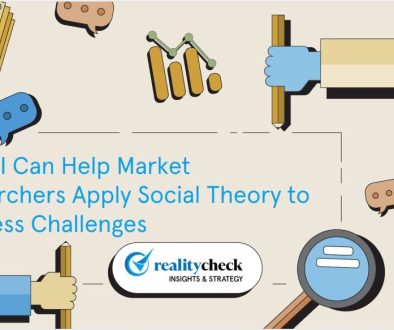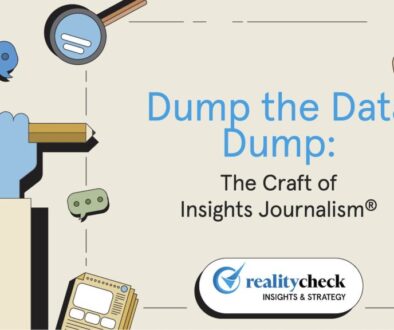Consumer Research Methods: Uncovering the 10% That Matters Most – and Reporting it to the C-suite
As a former journalist, I always try not to bury the lead. So here it is. Ninety percent of what is reported in most market research studies is already known.
Real value comes from reporting the 10% your audience doesn’t know. Never is this more important than when you’re reporting to your senior leadership team.
These days, insight professionals have unprecedented access to data about their customers. Most major brand marketers have communities, work with social media listening partners, monitor CX and subscribe to syndicated research on their categories. This is all in addition to the custom research they do. All of this means a continuous flow of consumer data.
The problem isn’t access to data. The problem is making sense of it all. That’s what we call the 10%.
The 10% is the lead. It’s the signal in the noise. It’s the most compelling, relevant, new news that brands need to know to move their business forward.
Who has time to wade through a 100-page deck? Do you? Certainly not the C-suite. What they want to know is what is the new information that matters most to the business.
So here are a few tips for uncovering and communicating the 10% that, when applied, will help you and your team find the story in your data.
1. Know what you’re looking for
To uncover the 10%, it helps to know what you’re looking for. There are two criteria. Ten percent insights are new, and they are important. So, what qualifies as “new?” Certainly, something your audience doesn’t already know. But this doesn’t mean that the 10% must be from out in left field. In fact, it is seldom the case that an audience that has any knowledge of your category won’t know something related to your 10% insights. More often than not, the 10% is a reframe of what they already know. It’s an insight that gives them a fresh perspective or a different way to think about the consumer. It should provoke thought.
A 10% insight doesn’t have to make people say, “I never heard that before,” although that’s fine. It can also make people say, “Well, I never really thought of it like that.” Often, this response is more powerful because it’s seen by the audience as more credible. You’ve taken something they already know, an assumption or belief, and you’ve advanced their thinking about it, offered a twist, or perhaps, challenged its validity.
Offering a fresh perspective on existing knowledge is often more palatable and more credible than insights that are totally new.
And this leads to our second criteria. 10% insights are important. They matter to the audience. They are a direct hit on the study objectives. It’s easy to find new insights about some obscure part of your data set. But what’s most interesting to your audience is the stuff that is directly related to the core objectives of the analysis. The big important stuff you’re after.
So, to recap, know what you’re looking for. The 10% are insights that are new – they offer a twist or a reframe of existing knowledge – AND they are important – they matter to your audience. They are a direct hit on the primary objectives of your analysis.
2. Don’t bury the lead
Once you’ve uncovered the 10% in your data, you need to communicate it clearly and concisely. That means lead with it. The 10% should be communicated on your first slide, in your first paragraph, in the first sentence. Make it clear, concise and direct. In journalism, when you fail to report the new, relevant information in the first paragraph, it’s called burying the lead. Journalists know that if you don’t hook the audience with something new and something that matters to them right off the bat, you’ll lose them. And this is true of consumer insight audiences too.
Despite this, insight folks and market researchers are notorious for burying the lead. Too often, I see research reports that report what was found in the order of the questionnaire or discussion guide. Or, in mixed methods studies, organized by type of fieldwork. Or worse yet, in no particular order at all – a data dump of disconnected slides.
Instead, lead with the 10%. Hit ‘em with it right out of the gate. Begin with your conclusion. Then, build your supporting story around that.
When I make this point, I always get some push back from those who say, “Well don’t you have to lead the audience to your big reveal?” In other words, don’t you have to build your case before you reveal your conclusion? To which I say, be careful. The slow burn is a good way to lose your audience quickly. Ninety-nine percent of the time, I believe it’s best to hit them with the 10% immediately, then support that insight.
3. Keep it tight
We all have a tendency to want to include everything we’ve found in our reports. For some of us, that’s because we’ve worked hard and have so much good stuff, we want to include it all. For others, it’s because we want to beat our audience into submission with tonnage, overwhelming any possible pushback with the sheer volume of data we’ve collected. Death by a thousand graphics.
I have one word for you here. Don’t.
Resist the temptation toward tonnage. Instead, craft a tight narrative around your 10% insights and let go of the rest. Let it go!
If you really must include it all, put it in the appendix. In fact, including an appendix in your report can be quite liberating.
The bottom line is your analysis is meaningless unless people act on it. And to act on it they have to remember it. And the more you bury people with information, the less they remember any of it. Keep in mind that people remember stories. They don’t remember data points. And they certainly don’t remember a ton of data points.
So, keep it simple. Deliver the 10%. Build a tight, compelling story around it, and let go of the rest.
4. Design with the 10% in mind
I’ve done presentations and facilitated workshops on uncovering and communicating the 10% and at some point, the same question always comes up. What if you don’t have anything new to report?
Oftentimes, the person raising this question will give the example of tracking studies, for which, they’ll say, the job usually is to update the team on the fact that “nothing has changed.” My first response to this is that if you’re repeating a study or method that routinely generates no new learning, then I’d seriously question why you’re spending money on it.
But my second response is that uncovering the 10% doesn’t start with analysis and report writing. You should think about it when you design your study. If you design your study to confirm what’s known, you’re going to end up confirming what’s known and delivering no new, relevant insights.
If you don’t actively seek new learning, you won’t find it.
To prevent this from happening, you should try to reframe the study objectives from the get go. Think about your team’s assumptions. How might they be wrong or incomplete? Think about what parts of your consumers’ lives and experiences might be connected to your study objectives that you haven’t explored in past research. Take a step back and ask yourself, what is this study really about? Set up interesting comparison groups and reference points in your design. Make sure you’ve created the kind of variance around key measures that will be interesting in analysis on the back end.
There are no hard and fast rules here other than approach your design with a fresh eye. And you’ll be more likely to get fresh, 10% insights.
I used to have a boss in this business who would say, “How do you get interesting insights? Ask interesting questions.” Make sure you have interesting, albeit relevant, questions built into your study that stack the deck in your favor of uncovering new insights that matter to your audience; that uncover the 10% that matters most.
So, there you have it. Four keys to uncovering the 10% and finding the story in your data. I hope you’ve found this useful.
And, as always, let us know what you think. If you need our help, reach out and let’s talk.
























